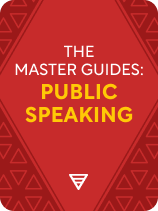

This article is an excerpt from the Shortform book guide to "The Master Guides: Public Speaking" by Shortform. Shortform has the world's best summaries and analyses of books you should be reading.
Like this article? Sign up for a free trial here.
How do you keep an audience interested in your speech? After you give your opening, how do you keep your audience with you?
To keep audience attention during a presentation, use interaction, strategic pauses, and shock value. This will keep your audience paying attention to your speech as you continue.
Learn how to keep audience attention during a presentation with these strategies.
Keep Your Audience’s Attention
Just as it’s important to know how to successfully engage an audience at the start, it’s critical to know how to keep audience attention during a presentation. Here are two techniques that can help you liven up a lukewarm audience:
- Interact with audience members. Ask questions that require them to shout out answers or raise their hands. You can also encourage them to say or share something with a neighbor.
- Use pauses strategically. When you stop talking, people naturally return their focus to you as they wonder what caused the sudden silence.
Another way to keep your audience captivated is to shock them. Carmine Gallo writes that shocking moments stick in people’s minds—according to neuroscientists, they heighten our emotions and cause our brains to perceive and remember information more vividly. The more your audience thinks about the shocking moment, the more they contemplate the idea you were trying to get across—and the more likely they are to act on that idea.
Gallo recommends several techniques to create a shocking moment:
Technique 1: Bring an unusual prop to your talk. For example, neuroscientist Jill Bolte Taylor brought a real human brain to her TED talk about neuroscience. The brain disgusted her audience, but it also grabbed their attention.
Technique 2: Give a demonstration. This method is particularly useful if you’re presenting a product. Showcase the item’s unique selling points. Your audience will hopefully be shocked by how impressive it is.
Technique 3: Include startling statistics. For example, when giving a TED talk on psychopathy, author and journalist Jon Ronson revealed that one in every hundred people is a psychopath—a high statistic that grabbed his audience’s attention.
Technique 4: Display a jarring photo or video. For instance, if you’re discussing the horrors of war, you could include images of war-torn communities to shock your audience into recognizing the pain that conflict causes.
Technique 5: Create a sound bite and use it in your presentation. A sound bite distills your main argument into a short, snappy, and memorable sentence. You can transform your sound bite into a shocking moment by making it particularly emotionally charged.

———End of Preview———
Like what you just read? Read the rest of the world's best book summary and analysis of Shortform's "The Master Guides: Public Speaking" at Shortform.
Here's what you'll find in our full The Master Guides: Public Speaking summary:
- How you can master public speaking—even if you fear it more than death
- Insights from leading experts on how to prepare and deliver a speech
- How to keep your audience's attention and stop them from losing focus






